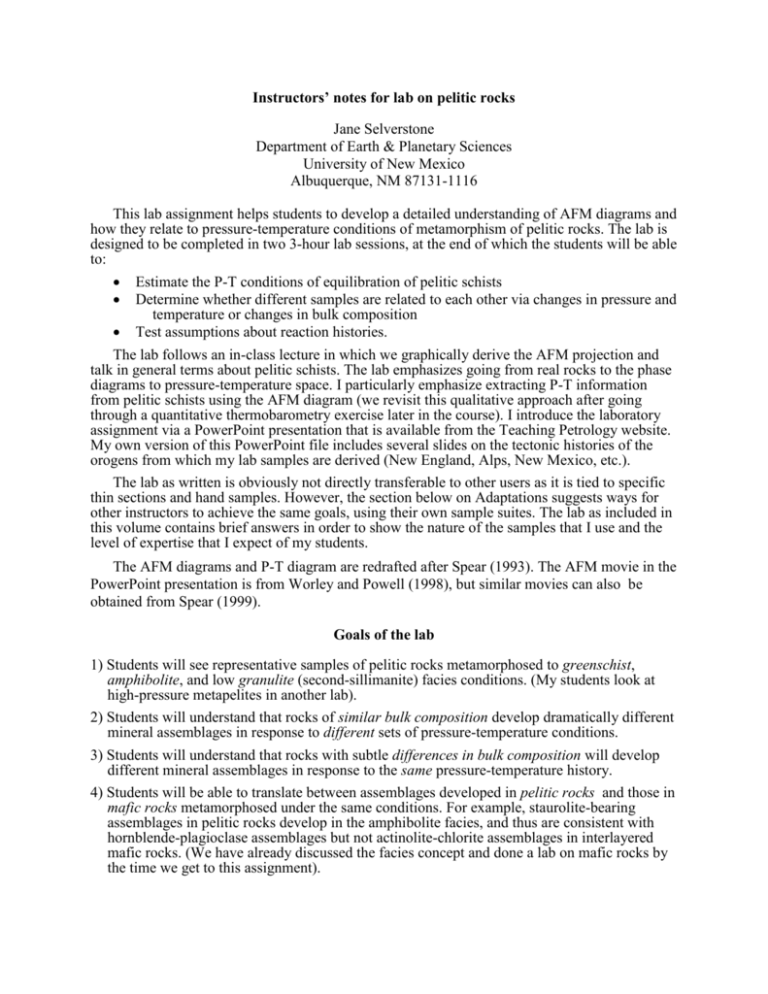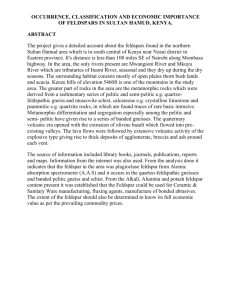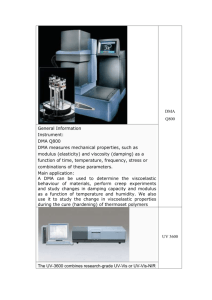Goals of the lab on pelitic rocks and
advertisement

Instructors’ notes for lab on pelitic rocks Jane Selverstone Department of Earth & Planetary Sciences University of New Mexico Albuquerque, NM 87131-1116 This lab assignment helps students to develop a detailed understanding of AFM diagrams and how they relate to pressure-temperature conditions of metamorphism of pelitic rocks. The lab is designed to be completed in two 3-hour lab sessions, at the end of which the students will be able to: Estimate the P-T conditions of equilibration of pelitic schists Determine whether different samples are related to each other via changes in pressure and temperature or changes in bulk composition Test assumptions about reaction histories. The lab follows an in-class lecture in which we graphically derive the AFM projection and talk in general terms about pelitic schists. The lab emphasizes going from real rocks to the phase diagrams to pressure-temperature space. I particularly emphasize extracting P-T information from pelitic schists using the AFM diagram (we revisit this qualitative approach after going through a quantitative thermobarometry exercise later in the course). I introduce the laboratory assignment via a PowerPoint presentation that is available from the Teaching Petrology website. My own version of this PowerPoint file includes several slides on the tectonic histories of the orogens from which my lab samples are derived (New England, Alps, New Mexico, etc.). The lab as written is obviously not directly transferable to other users as it is tied to specific thin sections and hand samples. However, the section below on Adaptations suggests ways for other instructors to achieve the same goals, using their own sample suites. The lab as included in this volume contains brief answers in order to show the nature of the samples that I use and the level of expertise that I expect of my students. The AFM diagrams and P-T diagram are redrafted after Spear (1993). The AFM movie in the PowerPoint presentation is from Worley and Powell (1998), but similar movies can also be obtained from Spear (1999). Goals of the lab 1) Students will see representative samples of pelitic rocks metamorphosed to greenschist, amphibolite, and low granulite (second-sillimanite) facies conditions. (My students look at high-pressure metapelites in another lab). 2) Students will understand that rocks of similar bulk composition develop dramatically different mineral assemblages in response to different sets of pressure-temperature conditions. 3) Students will understand that rocks with subtle differences in bulk composition will develop different mineral assemblages in response to the same pressure-temperature history. 4) Students will be able to translate between assemblages developed in pelitic rocks and those in mafic rocks metamorphosed under the same conditions. For example, staurolite-bearing assemblages in pelitic rocks develop in the amphibolite facies, and thus are consistent with hornblende-plagioclase assemblages but not actinolite-chlorite assemblages in interlayered mafic rocks. (We have already discussed the facies concept and done a lab on mafic rocks by the time we get to this assignment). 5) Students will be able to use their thin section and hand sample observations to determine AFM topologies. They will then use the AFM topologies to constrain the pressure-temperature conditions of final equilibration of each sample. 6) Students will develop and evaluate hypotheses to explain the coexistence of “too many minerals” on an AFM diagram. This goal is designed to blend understanding of thermodynamic concepts with interpretation of thin section textures. 7) Students will develop some appreciation for map and outcrop patterns, and for causes of sample heterogeneity in individual suites of rocks. 8) Students who choose to do the extra credit question will gain experience in constructing PTt paths from thin section observations, and in thinking about the tectonic implications of these paths. Adaptations for other users The goals of this lab could be satisfied using samples from many different metamorphic terranes around the world. A few specific suggestions follow. Goals 1, 2, 4, and 5 could be satisfied with any collection that includes samples from the greenschist, amphibolite, and low granulite facies. Specific assemblages/rocks that I would include are: chloritoid-chlorite, garnet-chlorite-biotite, any staurolite schist, and an example of each of the three Al2SiO5 polymorphs. An example of a sillimanite–K-feldspar rock would also help students to understand the AFM projection better. The samples need not all be from a single metamorphic terrane, although if they are there are more possibilities to incorporate map reading and tectonic thinking into the lab. Goal 3 is most readily satisfied by using two or three samples from a single outcrop that differ slightly in bulk composition. Students then realize that P and T should have been the same for each of the samples, and that different mineral assemblages must result from differences in bulk composition. This is most obvious once they look at the AFM diagrams. If such samples are not available, it is also possible to combine two unrelated samples that overlap in P-T space – for example, a garnet-biotite-chlorite schist and a garnet-staurolite-chlorite schist. Goal 6 requires the use of a sample containing at least four minerals that can be plotted on an AFM diagram – e.g., garnet-biotite-staurolite-chlorite. Some of the likely explanations that students should be able to propose are: (a) the assemblage is univariant, in which case they should be able to see textural evidence to support the required reaction; (b) chlorite is retrograde and did not equilibrate at the same P-T as the other minerals – in this case, there should be textural evidence for chlorite rimming garnet or interleaved with biotite or pseudomorphing staurolite; or (3) one of the minerals contains an extra component – Ca or Mn in garnet or Zn in staurolite would be likely candidates – and there would probably be no textural evidence of reaction. Goal 7 can be readily attained using a suite of samples from a single metamorphic terrane – any terrane, anywhere in the world will do, as long as maps (and photos) accompany the lab. I always give a brief PowerPoint overview of the tectonic history of each area discussed in the lab and have maps and outcrop photos available in the lab room. Goal 8 can be attained to some degree by using any sample(s) with inclusions in porphyroblasts and/or complex reaction textures – anything that gives students a feeling for movement of rocks across reactions in P-T space, rather than static equilibration between such reactions. Files Files necessary for this sample lab activity include the following: 1) JS pelitic lab.doc: Word file containing the lab assignment, with brief answers to questions given in italics throughout. 2) JS AFMs.pdf: One-page handout showing changing AFM topology with increasing metamorphic grade. Modified from Spear (1993). Letters correspond to labeled divariant fields on accompanying P-T grid. 3) JS P-T grid.pdf: P-T grid showing reactions responsible for changing AFM topologies. Labeled fields correspond to AFM diagrams on accompanying handout. 4) JS pelitic lab.ppt: PowerPoint introduction to the lab. References cited Spear, F.S. (1993) Metamorphic Phase Equilibria and Pressure-Temperature-Time Paths. 799 p. Mineralogical Society of America Monograph 1, Washington, D.C. Spear, F.S. (1999) Real-time AFM diagrams on your Macintosh. Geological Materials Research, 1, no. 3, 1-18. Worley, B. and Powell, R. (1998) Making movies: phase diagrams changing in pressure, temperature, composition, and time. In Treloar, P.J. and O’Brien, P.J., eds., What Drives Metamorphism and Metamorphic Reactions? Geological Society of London special publication, 138, 269-290.







